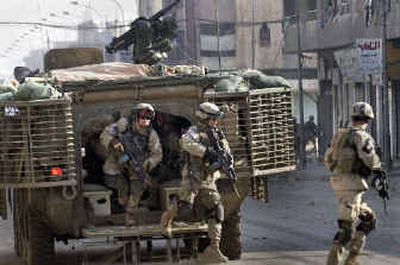Strykers are passing muster with soldiers

MOSUL, Iraq – For soldiers inside the U.S. Army’s newest troop transport vehicle, the armored combat Stryker rides like a cross-town bus as it sways softly atop its rubber tires, its brakes hissing quietly – before the back shoots open and troops leap onto the streets of one of Iraq’s most dangerous cities.
Some 300 Strykers are patrolling northern Iraq after their September 2003 introduction – vanguard of a multibillion dollar program that commanders say boosts their chances in a largely hit-and-run battle with insurgents.
Rank-and-file soldiers hailed the Stryker during recent patrols in Mosul as faster, quieter and safer than other combat vehicles – despite last week’s internal Army study that found numerous design flaws.
“We’ve been hit with (roadside bombs) and rocket-propelled grenades several times. We have taken direct machine-gun fire,” said Spc. George May of the 1st Brigade, 25th Infantry Division based in Fort Lewis, Wash. “The Stryker has saved everyone’s lives at least once. It’s perfect for what we’re doing, which is urban warfare.”
Strykers are designed to carry troops on patrols and into combat – like Bradley fighting vehicles, or the Humvees that have come under criticism for lacking proper armor. But while the boxy Strykers somewhat resemble tanks, they generally lack heavy cannons and are propelled by wheels instead of tracks.
In Mosul, Iraq’s third-largest city with more than 2 million people, the Strykers race along main streets and creep quietly through winding back alleys, searching for insurgents who bury artillery shells and mines in roadsides and target the vehicles with rocket-propelled grenades.
Soldiers say the Stryker is quieter, allowing them to sneak up on the enemy. And they say its partially jury-rigged armor guards them better than Humvees.
Unlike the tank-like, tracked personnel carriers that predominate across the rest of Iraq – such as the Bradley – the four wheels on either side of the 19-ton Stryker give it speed, stealth and mobility that allows it to outmaneuver insurgents, officers say.
“For what we’re doing, I think the Stryker is excellent,” said May, a 27-year-old native of Upper Dublin, Pa.
Still, an Army report from the Center for Army Lessons Learned found the vehicle bogs down in mud and the engine strains under the 5,000-pound armor added by the Army.
The report also said the armor’s extra weight has caused problems with the automatic tire pressure system, requiring crews to check the tires three times a day.
“The Army should not put inadequately tested equipment in the field, as it creates a false impression that the troops are properly equipped to fight in combat,” said Eric Miller, who investigates defense issues for the oversight group.
In Iraq, infantrymen and officers bridled at the report, saying many of the problems have been fixed and insisting the Stryker’s speed – upward of 60 mph – outweighs any deficiencies.
“For what we’re doing, the Stryker is much better than a Bradley because it’s much faster and quieter,” said Spc. Michael Neel, a 24-year-old Stryker driver from Ridgecrest, Calif., who has also piloted a Bradley.
The $7 billion Stryker program is intended as a stepping stone to the ultimate goal: a high-tech family of fighting systems known as the Future Combat System, expected to include unmanned ground and aerial vehicles.
Officers say the Stryker is part of a larger drive by the Pentagon to turn the Army into a fighting force that can react to threats more quickly.